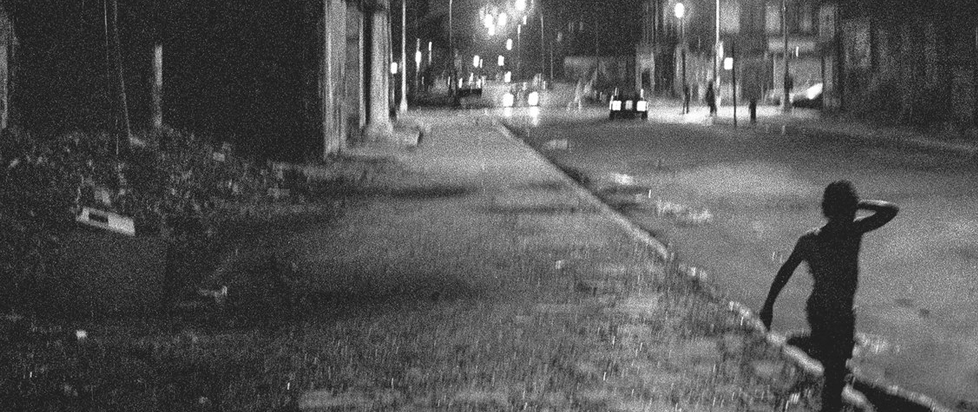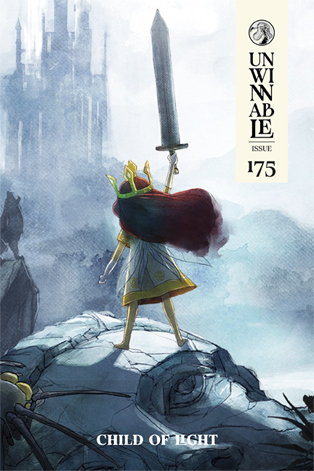
May 2024

This column is a reprint from Unwinnable Monthly #175. If you like what you see, grab the magazine for less than ten dollars, or subscribe and get all future magazines for half price.
———
Ruminations on the power of the riff.
———
Once in my early college years, I was loading in my gear to play a show with my band in a VFW basement. A patron on his way to the bar upstairs stopped me in the entranceway to ask a few questions about what was going on downstairs and what kind of music we played. Before we went our separate ways, he told me, “I used to be in a band but now I’m creatively stagnant. Have fun down there.”
That quote still haunts me two decades later. As a recent father who is approaching 40 years old, I understand that priorities change with age, and I don’t look back at that exchange with any sort of judgement. There will come a time where I write my last piece, play my last show, or discover the last new record that moves me so much I have to tell someone about it. Yet I also wonder whether people leave punk rock behind not because they have outgrown it, but because they didn’t realize that growing with the form was an option.
When sorting through recent releases to cover in this space, I noticed a pattern of bands from various areas of the punk landscape putting out new and vital work well into their 30s, 40s and 50s, proving its possible for punk (in its various strands) to allow not only for nostalgia past your teens and 20s but for lifelong growth and reinvention. What follows is a selection of records in my current listening rotation that have served as a collective reminder that even though your relationship to music might change, there’s no reason to believe there’s some sort of age cutoff where your place on stage has to be replaced with a seat at the bar.

Restorations – Restorations
When I spoke with Restorations frontman Jon Loudon for a small music blog in 2013, I asked how the band managed to balance being in a touring band while holding down careers outside of music. The answer was that they don’t make the band their number one priority. This would become a common response any time I’d ask the same question to other bands in their 30s and 40s that had spent most of their 20s staring at the inside of a van. Making space for music to fit around other priorities can be the difference between breaking up the band and having a slow but sustainable career.
This approach means that new releases from Restorations are somewhat few and far between – their recently released self-titled fifth album marks the band’s first recorded output since 2018’s LP5000 – but it’s also what allows them to release music at all.
They’ve shared across social media that this was a difficult record to make, but if that’s true, it doesn’t show in the final product. Imagine the lead guitar lines from Caution-era Hot Water Music fused with the distorted bass stomp of Torche churning underneath The Hold Steady’s brand of cinematic storytelling, and you might have an inkling of what Restorations sound like. and that’s as close as I can get to accurately describing what Restorations sound like.
The lyric “You’re still a kid to the grownups / And you’re still a cop to the kids” on “Someone Else’s Dream” is perhaps the best summation of feeling stuck between worlds as an aging punk and a young (or not that young) professional, and if that feels in any way relatable, your anthems are waiting for you here.

J. Robbins – Basilisk
Despite being a legendary name in punk and hardcore circles both as a performer and producer with a resume that’s far too long to do justice in this space, I’ve never made myself familiar with much of his solo work until now. Basilisk offers off-kilter alternative rock-inflected post-hardcore that should feel familiar to anyone who’s spent time with albums from Jawbox or Burning Airlines (perhaps his two best-known prior acts).
In a better world, this is the sound from the ’90s that would become synonymous with radio rock. It’s experimental enough to avoid predictability and yet catchy and accessible enough to immediately grab and hold your attention. “Exquisite Corpse” stands out as a single that could have been, if singles were still something that mattered like they did in the mid-’90s.

C. L. S. M. – Infinity Shit
I’m not exactly sure what the story is behind Coliseum adopting the C.L.S.M. moniker for Infinity Shit, their first new album in nine years, but I couldn’t be happier to see them back in action. The last time we heard from the Louisville three-piece, they were leaning into melodic mid-tempo rock on 2015’s Anxiety’s Kiss, disbanding shortly after its release.
The world has offered ample fodder to inspire devasting D-beat infused hardcore punk since then, which is exactly what vocalist/guitarist Ryan Patterson and company have delivered here with little-to-no advance warning. If anyone was wondering where their collective heads and hearts are at after nearly a decade away, the title of the opening track “Dehydrated Flesh of the Bourgeoises” should serve as a suitable vibe check. They’re pissed. And that’s great news.
For the most part, Coliseum (C.L.S.M.?) spend most of the record’s 21-minute runtime righteously spitting bile over riffs that rip as hard as anything they’ve ever released since their self-titled 2004 debut and its 2007 follow-up No Salvation. Yet while Infinity Shit treads across well-worn territory, they haven’t abandoned experimenting with new sounds and textures by any means. The saxophone lines that appear mid-album on “Behind the Sheltering Sky” could be seen as a gimmick if they didn’t work so well to accentuate the track’s ominous tension.
 Her Head’s On Fire – “Why Are We Alone”
Her Head’s On Fire – “Why Are We Alone”
While it seems like every ’90s emo and hardcore band has been getting back together for reunion tours lately, Her Head’s On Fire is instead an all-new project that includes scene luminaries from Garrison, Small Brown Bike, Saves The Day and The Bomb. While their second full-length Strange Desires (which follows up their 2022 debut College Rock and Clove Cigarettes) won’t be available until July, I’ve already listened to the first teaser single “Why Are We Alone” they’ve shared more times than I can count. This is energetic post-hardcore that feels like a continuation of the band’s considerable collective legacy rather than an attempt to recapture former glory.

Hot Water Music – Vows
Between their main band and various side projects, I don’t think any of the members of Hot Water Music have taken a substantial break from music since their formation in the early 1990s. While the full record is still four days away from release as of this writing (which, yes, is past my deadline, if you were wondering), they’ve shared enough tracks on streaming platforms to get the sense that this will be another banger in a deep catalog with no misses. This will be their second record with Chris Creswell from The Flatliners as a full-time member and that combination still feels like the punk equivalent of Lebron James traveling back in time to join Michal Jordan and the ’96 Bulls. I’ll leave this blurb there.

Pelican – Adrift/Tending the Embers
Pelican have been a model of consistency since their formation in the early 2000s and the pair of tracks on this EP do not disappoint. Heavy, atmospheric and seeing no need for vocals, this is a band that sells T-shirts reading “post-emo stoner deathgaze,” a genre descriptor that is both absurd and on point. Their 2005 breakthrough The Fire in Our Throats Will Beckon the Thaw was a fixture in my listening rotation as a college sophomore, and even after all these years, it’s possible that their best output may still be ahead of them. There’s something both comforting and motivational about that.

Paint It Black – Famine
I’ve already written an entire column this year about this record, but they fit the premise of this piece too well not to mention them again. Paint It Black embody not only the ethos of releasing records on their own timeline, but of refusing to compromise your values and ethics. This is 16 minutes and 17 seconds worth of urgency and anxiousness about a world that gets a little bit darker every day. Words like “Not everyone is free / And that doesn’t feel safe to me” function not only as an expression of despair, but as a reminder not to settle deep enough into middle-class comfort to forget that a better world is possible.
———
Ben Sailer is a writer based out of Fargo, ND, where he survives the cold with his wife and dog. His writing also regularly appears in New Noise Magazine.




